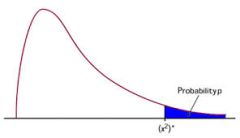F-test for the Equality of Two Population Variances
Instructions: This calculator conducts an F test for two population variances in order to assess whether two population variances \(\sigma_1^2\) and \(\sigma_1^2\) can be assumed to be equal or not. Please select the null and alternative hypotheses, type the sample variances, the significance level, and the sample sizes, and the results of the F-test will be presented for you:
F-test for the Equality of Two Population Variances
More about the F-test for two variances so you can better understand the results provided by this solver: An F-test for equality of variances is a hypothesis test that is used to assess whether two population variances should be considered equal or not, based on sample data from both populations. More specifically, with information about the sample variances, from samples coming from the two populations, a test statistic is constructed to assess whether or not there is enough evidence to claim that that variances are unequal.
The test, as every other well formed hypothesis test, has two non-overlapping hypotheses, the null and the alternative hypothesis. The null hypothesis is a statement about the population variances which represents the assumption of no effect (in this case, that the population variances \(\sigma_1^2\) and \(\sigma_2^2\) are equal), and the alternative hypothesis is the complementary hypothesis to the null hypothesis (in this case, that the population variances \(\sigma_1^2\) and \(\sigma_2^2\) are unequal). The main properties of a F-test for two population variances are:
- The test statistic has a F-distribution, with n 1 and n 2 degrees of freedom
- The F distribution is one of the most important distributions in statistics, together with the normal distribution and the Chi-Square distribution
- Depending on our knowledge about the "no effect" situation, the F-test can be two-tailed, left-tailed or right-tailed
- The main principle of hypothesis testing is that the null hypothesis is rejected if the test statistic obtained is sufficiently unlikely under the assumption that the null hypothesis is true
- The p-value is the probability of obtaining sample results as extreme or more extreme than the sample results obtained, under the assumption that the null hypothesis is true
- In a hypothesis tests there are two types of errors. Type I error occurs when we reject a true null hypothesis, and the Type II error occurs when we fail to reject a false null hypothesis
The formula for a F-statistic is
\[F = \frac{s_1^2}{s_2^2}\]The null hypothesis is rejected when the F-statistic lies on the rejection region, which is determined by the significance level (\(\alpha\)) and the type of tail (two-tailed, left-tailed or right-tailed).



